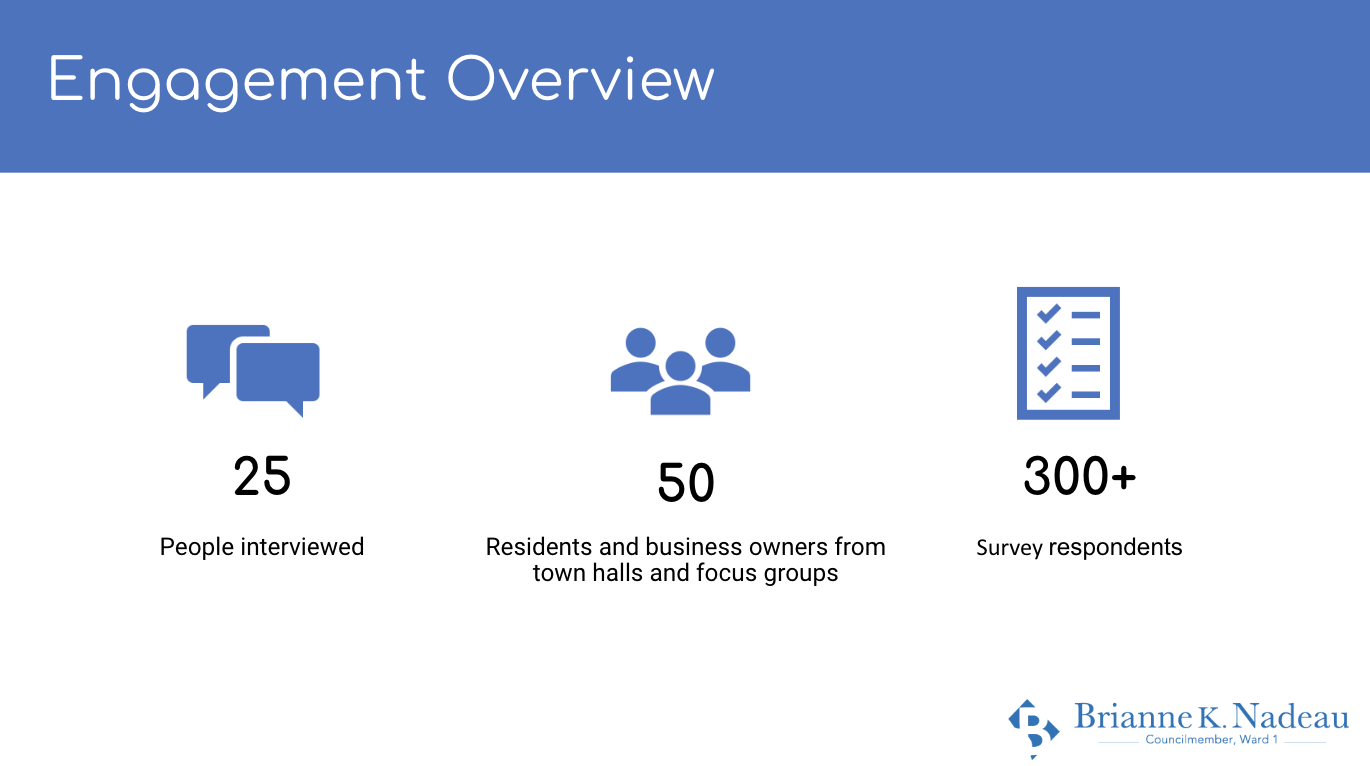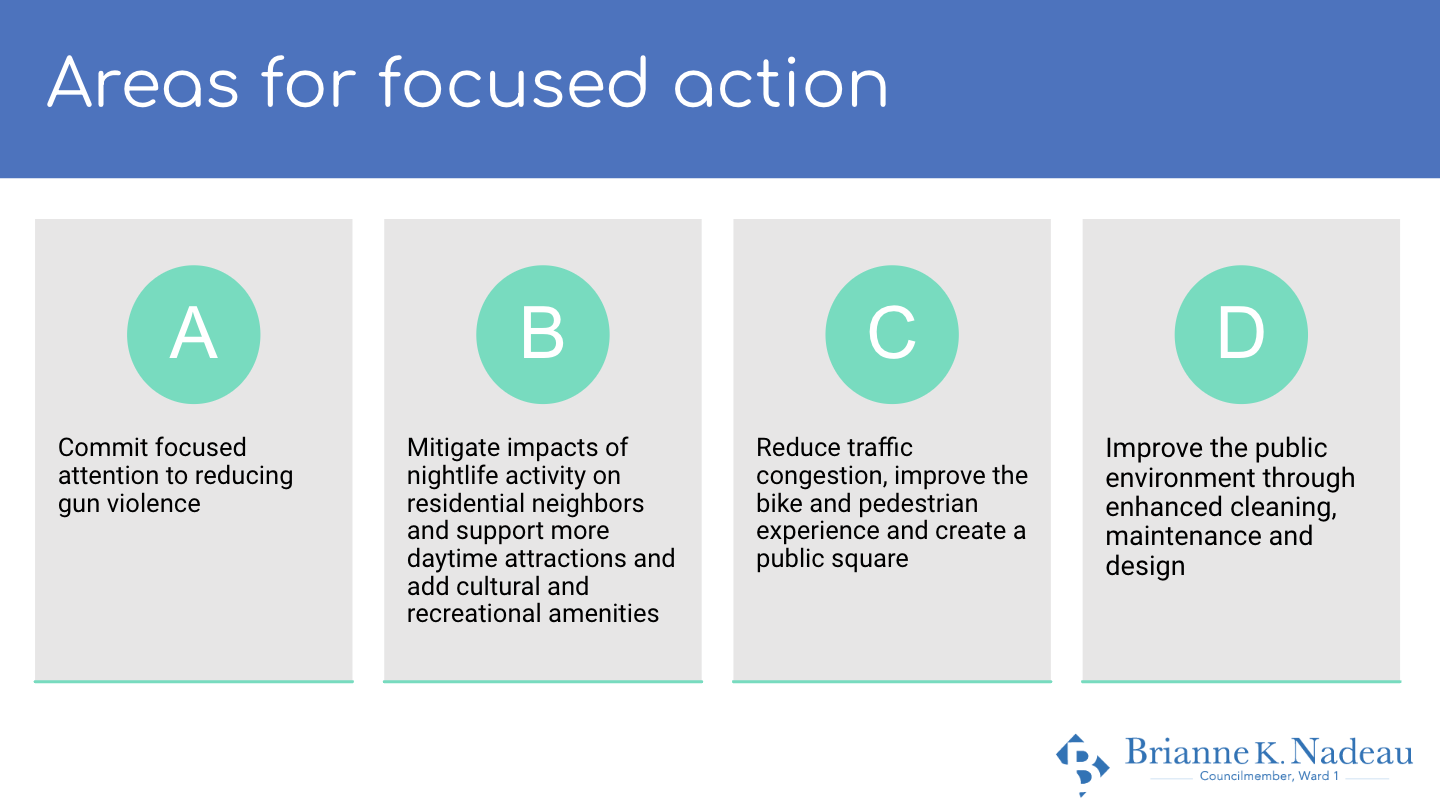December 2022 Update on the U Street Safety Initiative
This summer, I formed the U Street Safety Initiative, a public engagement and planning process meant to bring neighbors, businesses, organizational and government partners together to create a roadmap for improved safety and vitality on this culturally important corridor.
You can read the previous U Street Safety Initiative update here.
Since then, we have solicited and heard a lot of diverse feedback, concerns, and ideas for U Street's future. We held multiple virtual and in-person focus groups, had over two dozen one-on-one interviews, and received over 300 survey responses from residents, business owners, and many others who have an interest in the greater U Street. I have also been meeting with officials from across DC government to share our findings and ensure we follow through on implementation.
In this update, I want to share the framework of recommendations that has been put together by my office in collaboration with our engagement team and an advisory committee representing a balance of residents, business owners, government agencies, and institutional partners.
These core recommendations will go on to inform the final report, to be released in December. If you have thoughts, comments, or questions on this framework, I'd love to hear them. The full presentation outlining the recommendations can be found at the end of this post.

About the U Street Safety Initiative:
The greater U Street area was identified as needing coordination for a number of reasons, including increase in violent incidents, volume and consistency of constituent services casework handled by the my office, pandemic-related shifts in the commercial market and bar operations, and an urgent need to jumpstart planning and coordination efforts; while many of recommendations from previous efforts like the Duke Plan have been implemented, many others have not. It's critically important to build on lessons learned from past plans and guide new planning efforts.
While 14th and U is often synonymous with DC’s 21st century surge in economic development and population, in many ways the corridor remains under-invested. Public sector resources and services have not kept pace with U Street’s substantial private development and continued growth as a nightlife destination. This has led to serious safety concerns and an overall feeling of disorder shared by a diverse group of respondents.
In addition, there are emerging opportunities and drivers of change in the neighborhood. Three large public sites at 1617 U Street, the Reeves Center, and Housing Finance Agency headquarters – are in planning or pre-development, with a fourth public site not far to the south on S and 14th Streets. Development of Howard University properties in Pleasant Plains just to the north will create a new regional destination.
In June 2022, Mayor Bowser launched a Nightlife Task Force, bringing increased enforcement and outreach resources to U Street (along with other nightlife centers in the District) to reduce crime, enforce traffic and parking regulations, address quality-of-life issues like ATVs, and identify gaps in staffing and resources.
The U Street Safety Initiative was designed to complement this critical effort in two ways. In the immediate term, my office is sharing information and feedback developed with the Mayor’s Taskforce to help evaluate its impact and plan for future deployments. Over the long term, this initiative will lay the groundwork for holistic, longterm strategies to improve conditions on U Street and to help it live up to its history and its potential as one of the nation's most dynamic, vibrant and culturally significant neighborhoods.

4 Building Blocks for Action:
As a framework for building out the full report and recommendations, four core building blocks have been established:
Building Block 1 - Create and Fund a Place Management Entity
U Street area has benefitted from Commercial Clean Team and Main Street programs in multiple ways. I was proud to be able to fund and help stand up these services. However, the scale and scope of these programs do not match the complexity of needs and priorities in Greater U Street. A more robust, cross sectoral approach is needed to ensuring the neighborhood is vibrant, safe, and livable.
My office is committed to laying the foundation for an entity capable of bringing resources, coordination and expertise to the Greater U Street area's multifaceted challenges and enormous potential. Greater U Street needs an integrated and cross sectoral approach to providing enhanced cleaning services, fostering a more dynamic retail mix, coordinating around safety and traffic issues, marketing its cultural and daytime attractions and more. This will entail continued stakeholder engagement, exploration of place management funding and governance models and investment from both the public and private sectors.
This entity will:
- Align with widely agreed upon Greater U Street boundaries.
- Honor and build upon U Street’s cultural assets and legacy -- supporting those residents and establishments who continue the legacy of Black Broadway.
- Bring together place-based stakeholders including businesses, residents, nonprofits, property owners, and universities to collaborate on building a thriving, inclusive, and vibrant U Street.
- Work across multiple systems to provide enhanced cleaning, public safety, marketing, and community-building programming.
- Be governed by a non-profit organization with broad stakeholder representation.
- Leverage long-term sustainable funding mechanisms from both the public and private sector.
Building Block 2 - Pilot a Nightlife Venue Safety Initiative
Many business and residential stakeholders expressed dissatisfaction with the current tools in place to balance vibrancy, nightlife venue safety and livability.
I am committed to working with government, business and resident partners to support a more effective approach to mitigating negative impacts of nightlife activity on residential quality of life while also supporting the vibrant and diverse night time economy U Street is known for.
The initiative we envision will:
- Be designed with dense night life areas in mind.
- Focus on at-risk businesses (those with persistent violations and neighborhood complaints).
- Combine robust enforcement with well resourced technical assistance to improve venue safety and mitigate noise/trash impacts on residential neighbors.
- Involve a partnership with Mayor’s Office of Nightlife and Culture to intervene with at risk operators and provide code compliance support to operators throughout the corridor.
- Work with ABC Board and ABRA to focus enforcement resources on persistent violators.

Building Block 3 - Pilot an Enhanced Nightlife Zone Clean Team
In recognition of the additional maintenance needs of nightlife areas, and the need for focused attention on public safety, this Building Block recommends a full build-out of many of the successes of the Mayor's Night Life Task Force. This includes expanded cleaning and maintenance beyond what current resources can provide (and at all hours), as well as a neighborhood ambassador and outreach service, incorporating an extensive level of case management and support for team members.
Program design should cut across multiple needs -- cleaner streets, job training and employment, mental health support and outreach, and public safety.
Recommendations under this building block also include enhanced rodent and pest management; eliminating front trash pick-up, especially for businesses; and other trash management tools such as commercial compactors.
Building Block 4 - Invest in Greater U Street’s Public Realm, Infrastructure, and Mix of Uses
The final building block provides a foundation for all the others -- improving the public realm, streetscape infrastructure, and implementation of planning documents to achieve goals identified by public engagement, and to facilitate public safety and the longevity of the sense of pride in U Street as a diverse, vibrant, and welcoming place.
These improvements will:
- Create a more flexible street that can be responsive to changes in use throughout the day and week.
- Establish and maintain welcoming public spaces that reinforce U Street’s identity and its unique place in DC and the United States' cultural and civil rights history (public plazas 13th Street & 10th Street Metro Plazas, 14th/U, T Street).
- Employ a range of traffic calming strategies and design interventions to improve the pedestrian experience and make it easier to navigate by foot, transit, and bike.
- Implement planning and land use recommendations in the Duke Plan including the creation and support of more public gathering places, venues for arts and culture, and diverse business uses.
You can view the full presentation of these building blocks, as presented to the advisory committee earlier this fall, in the PDF below.
What's next? Further feedback and finalizing the report and recommendations, and incorporating our findings into upcoming policy and budget investments. Look out for more over the next few weeks.